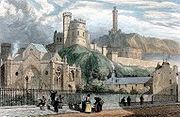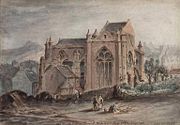
Trinity College Kirk
Encyclopedia



Collegiate church
In Christianity, a collegiate church is a church where the daily office of worship is maintained by a college of canons; a non-monastic, or "secular" community of clergy, organised as a self-governing corporate body, which may be presided over by a dean or provost...
in Edinburgh
Edinburgh
Edinburgh is the capital city of Scotland, the second largest city in Scotland, and the eighth most populous in the United Kingdom. The City of Edinburgh Council governs one of Scotland's 32 local government council areas. The council area includes urban Edinburgh and a rural area...
, Scotland
Scotland
Scotland is a country that is part of the United Kingdom. Occupying the northern third of the island of Great Britain, it shares a border with England to the south and is bounded by the North Sea to the east, the Atlantic Ocean to the north and west, and the North Channel and Irish Sea to the...
. The kirk
Kirk
Kirk can mean "church" in general or the Church of Scotland in particular. Many place names and personal names are also derived from it.-Basic meaning and etymology:...
and its adjacent almshouse
Almshouse
Almshouses are charitable housing provided to enable people to live in a particular community...
, Trinity Hospital, were founded in 1460 by Mary of Gueldres in memory of her husband, King James II
James II of Scotland
James II reigned as King of Scots from 1437 to his death.He was the son of James I, King of Scots, and Joan Beaufort...
. Queen Mary was interred in the church, until her coffin was moved to Holyrood Abbey
Holyrood Abbey
Holyrood Abbey is a ruined abbey of the Canons Regular in Edinburgh, Scotland. The abbey was founded in 1128 by King David I of Scotland. During the 15th century, the abbey guesthouse was developed into a royal residence, and after the Scottish Reformation the Palace of Holyroodhouse was expanded...
in 1848.
The church and hospital of Soutra Aisle
Soutra Aisle
Soutra Aisle, just within the Scottish Borders, not far from Fala, is the remains of the House of the Holy Trinity, a church that was part of a complex comprising a hospital and a friary...
dedicated to the Holy Trinity, was held as a prebend of the chancellor of St Andrews. In 1459/60 the chancellorship was vacant allowing the dowager
Dowager
A dowager is a widow who holds a title or property, or dower, derived from her deceased husband. As an adjective, "Dowager" usually appears in association with monarchical and aristocratic titles....
queen to supplicate Pope Pius II
Pope Pius II
Pope Pius II, born Enea Silvio Piccolomini was Pope from August 19, 1458 until his death in 1464. Pius II was born at Corsignano in the Sienese territory of a noble but decayed family...
for the annexation of Soutra to her Trinity College foundation – the sanctioning bull
Papal bull
A Papal bull is a particular type of letters patent or charter issued by a Pope of the Catholic Church. It is named after the bulla that was appended to the end in order to authenticate it....
was published on 23 October 1460. Queen Mary issued a charter
Royal Charter
A royal charter is a formal document issued by a monarch as letters patent, granting a right or power to an individual or a body corporate. They were, and are still, used to establish significant organizations such as cities or universities. Charters should be distinguished from warrants and...
on 25 March 1462 detailing the constitution for Trinity College in which the provost
Provost (religion)
A provost is a senior official in a number of Christian churches.-Historical Development:The word praepositus was originally applied to any ecclesiastical ruler or dignitary...
was to hold Soutra church as a prebend but had to maintain three bedesmen in the Soutra hospital.
Early records of the construction of the church are lost, but on 8 April 1531 the Provost Master John Dingwall contracted with a mason Robert Dennis that Dennis would work to complete the building for his lifetime. Dingwall wished to complete the church conforming to the choir. After his death in 1533, the masons pursued his legacy left for completing the work. Only the choir and transepts were finished. A nearby house, demolished in 1642, was called 'Dingwall Castle.' After the Scottish Reformation
Scottish Reformation
The Scottish Reformation was Scotland's formal break with the Papacy in 1560, and the events surrounding this. It was part of the wider European Protestant Reformation; and in Scotland's case culminated ecclesiastically in the re-establishment of the church along Reformed lines, and politically in...
the kirk became the North East Quarter Church of Edinburgh. During the 1590s, the kirk was used by Edinburgh University for graduation ceremonies.
Built in the shadow of Calton Hill, the gothic
Gothic architecture
Gothic architecture is a style of architecture that flourished during the high and late medieval period. It evolved from Romanesque architecture and was succeeded by Renaissance architecture....
kirk, and its associated hospital
Hospital
A hospital is a health care institution providing patient treatment by specialized staff and equipment. Hospitals often, but not always, provide for inpatient care or longer-term patient stays....
, were demolished in 1848, despite a formal protest from the Society of Antiquaries of Scotland
Society of Antiquaries of Scotland
The Society of Antiquaries of Scotland is the senior antiquarian body in Scotland, with its headquarters in the National Museum, Chambers Street, Edinburgh...
, to allow for the construction of Waverley Station. David Octavius Hill
David Octavius Hill
The Scottish painter and arts activist David Octavius Hill collaborated with the engineer and photographer Robert Adamson between 1843 and 1847 to pioneer many aspects of photography in Scotland.-Early life:...
and Robert Adamson
Robert Adamson (photographer)
Robert Adamson, was a Scottish pioneer photographer.Adamson was born in St. Andrews, he was hired in 1843 by David Octavius Hill , a painter of romantic Scottish landscapes. He was commissioned to make a group portrait of the 470 clergymen who founded the Free Church of Scotland. Hill required...
managed to take some photographs of the kirk before its demise. It was carefully dismantled and each piece of masonry was numbered with the intention of reconstructing the kirk on another site. Edinburgh Town Council received £16,000 from the North British Railway Company for the purpose of reconstructing the building, or building a substitute, but the funds were never used. However, one transept
Transept
For the periodical go to The Transept.A transept is a transverse section, of any building, which lies across the main body of the building. In Christian churches, a transept is an area set crosswise to the nave in a cruciform building in Romanesque and Gothic Christian church architecture...
and the choir were reconstructed in the 1870s, on Chalmers Close, just off the Royal Mile
Royal Mile
The Royal Mile is a succession of streets which form the main thoroughfare of the Old Town of the city of Edinburgh in Scotland.As the name suggests, the Royal Mile is approximately one Scots mile long, and runs between two foci of history in Scotland, from Edinburgh Castle at the top of the Castle...
, and, under the name Trinity Apse, now houses the Brass Rubbing Centre, under the auspices of the City of Edinburgh Council's Museum of Childhood
Museum of Childhood (Edinburgh)
The Museum of Childhood is a collection of items relating to children's toys and playthings, situated on the Royal Mile, in Edinburgh, Scotland.The building was once the Salvation Army's hall on the Royal Mile.-Ghosts:...
. The rebuilt Apse, together with carved stone fragments and the boundary wall, is registered as a Category A listed building by Historic Scotland
Historic Scotland
Historic Scotland is an executive agency of the Scottish Government, responsible for historic monuments in Scotland.-Role:As its website states:...
.
List of provosts
- Edward Bonkle: 1462 – 1495 x 1496
- James Oliphant: 1499 – 1525
- John Brady: 1502 – 1525
- John Dingwell: 1525 – 1532 x 1533
- William Cunningham: 1533 – 1539
- Thomas Erskine: 1539
- Robert Erskine: 1539 – 1540
- George Clapperton: 1540 – 1566
- Laurence Clapperty: 1566 – 1571 x 1572
- Robert Pont: 1572 – 1586
Source: Watt & Murray Fasti Ecclesiae Scoticanae
Note: One of the founding members of the College of Justice
College of Justice
The College of Justice is a term used to describe the Supreme Courts of Scotland, and its associated bodies.The constituent bodies of the supreme courts of Scotland are the Court of Session, the High Court of Justiciary, and the Accountant of Court's Office...
, John Dingwell, was Provost of Trinity College; and several Moderators of the General Assembly of the Church of Scotland came from the Trinity College Kirk:
- 1690 Hugh Kennedie AM
- 1719 James Grierson
- 1739 James Bannatyne
- 1740 George Logan
See also
- Berwick CastleBerwick CastleBerwick Castle is a ruined castle in Berwick-Upon-Tweed, Northumberland, England.The castle was founded in the 12th century by the Scottish King David I. In 1296-8, the English King Edward I had the castle rebuilt and the town fortified, before it was returned to Scotland...
, most of which was also demolished in 1847, to allow for the construction of the Edinburgh - Newcastle railway
External links
- Photographs of a communion plate, 2 communion cups and 2 communion flagons associated with Trinity College Kirk, Edinburgh; National Museums Scotland
- Archive of images of the kirk, held by the Royal Commission on the Ancient and Historical Monuments of ScotlandRoyal Commission on the Ancient and Historical Monuments of ScotlandThe Royal Commission on the Ancient and Historical Monuments of Scotland is an executive non-departmental public body of the Scottish Government 'sponsored' [financed and with oversight] through Historic Scotland, an executive agency of the Scottish Government...
- Image of Trinity Hospital, held by the Royal Commission on the Ancient and Historical Monuments of Scotland
- Photograph of a transept window, University of GlasgowUniversity of GlasgowThe University of Glasgow is the fourth-oldest university in the English-speaking world and one of Scotland's four ancient universities. Located in Glasgow, the university was founded in 1451 and is presently one of seventeen British higher education institutions ranked amongst the top 100 of the...
- Brass Rubbing Centre, the City of Edinburgh Museums & Galleries

